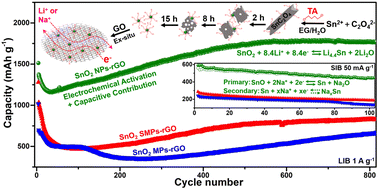A robust solvothermal-driven solid-to-solid transition route from micron SnC2O4 to tartaric acid-capped nano-SnO2 anchored on graphene for superior lithium and sodium storage†
Abstract
Tin dioxide (SnO2) has been widely implemented as an advanced anode material for lithium or sodium ion batteries (LIBs/SIBs) owing to its high capacity and moderate potential. However, conventional synthetic approaches often yield large-sized SnO2, which suffers from low conductivity, huge volume expansion and Sn coarsening issues, hampering its practical implementation. Herein, a unique solvothermal-driven solid-to-solid transition (SDSST) strategy is developed to craft tartaric acid (TA) capped ultrafine SnO2 nanoparticles (NPs) in situ on sacrificial SnC2O4 microrods. Ball-milling combined with solvent evaporation treatment realizes the homogeneous composition and precise mass ratio control of TA-capped SnO2 NPs and reduced graphene oxide (rGO). Remarkably, the SnO2 NPs-rGO nanocomposite manifests outstanding lithium and sodium storage capacities of 1775 and 463 mA h g−1 after 800 and 100 cycles at 1000 and 20 mA g−1, respectively, and an ultralong lifespan of 4000 cycles for LIBs. Notably, systematic electrochemical and componential characterization of the cycled electrodes reveals that SnO2 NPs-rGO manifests fully reversible three-step lithiation–delithiation reactions of SnO2 and a primary highly reversible sodiation–desodiation conversion reaction between Sn and SnO combined with a secondary partially reversible alloying–dealloying reaction between Sn and NaxSn (0 ≤ x ≤ 3.75) for lithium and sodium storage, respectively. The even encapsulation of TA-capped SnO2 NPs in the rGO matrix enables effectively suppressed volume expansion for outstanding structural stability, significantly accelerated ion/electron transport for superior reaction kinetics, greatly prohibited Sn coarsening for enhanced cycle reversibility, and dramatically increased capacitive capacity for additional energy storage. As such, the SDSST approach may represent a facile yet robust strategy for crafting a variety of nanomaterials of interest with appropriate metastable solids as the precursor under the assistance of efficient capping agents.



 Please wait while we load your content...
Please wait while we load your content...